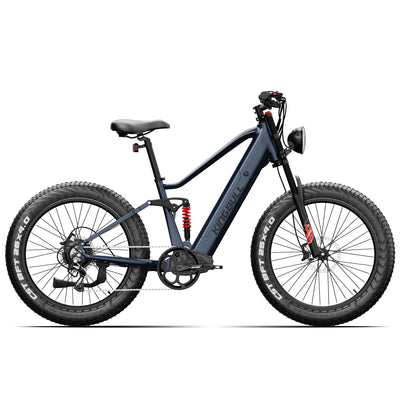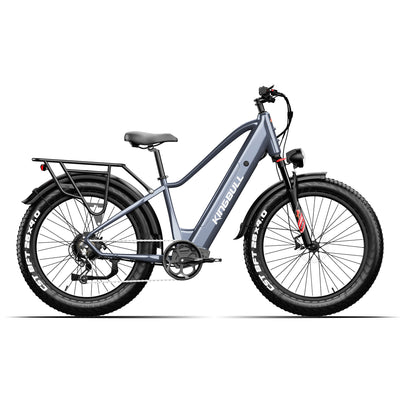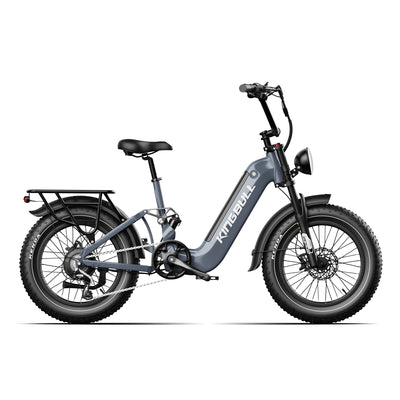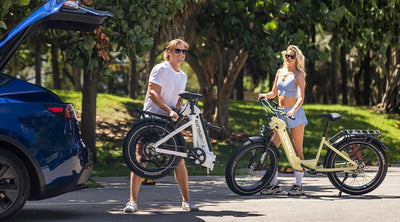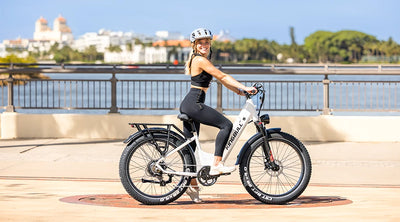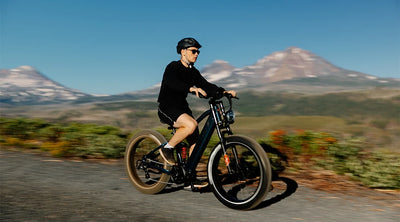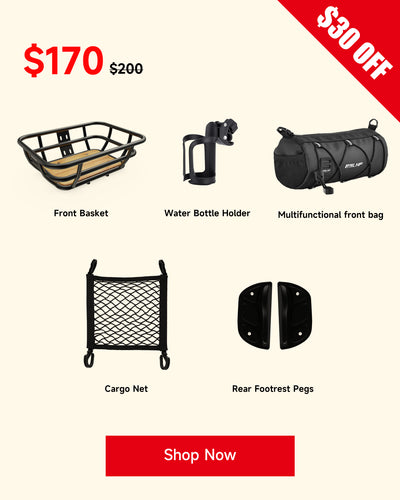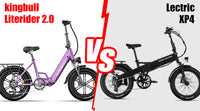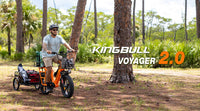Explore News
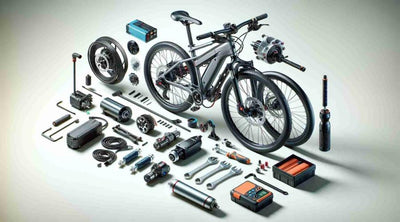
Maintenance
How To Troubleshoot An Electric Bike?
"Discover the secrets to maintaining your electric bike with our troubleshooting guide. From diagnosing power and battery issues to tackling electrical and mechanical problems, we'll walk you through step-by-step solutions. Save time and money while gaining a deeper understanding of your e-bike's inner workings for uninterrupted rides ahead."
The ability to troubleshoot an electric bike is a valuable skill for any e-bike owner. Mastering e-bike troubleshooting saves time, money, and hassle. Gain a deeper understanding of your bike's mechanics and make informed decisions when seeking help.Keep reading to learn how to identify and solve electric bike problems step by step. With our guidance, keep your journey smooth and uninterrupted.
Understanding Common Electric Bike Issues
Despite their efficiency and enjoyment, electric bikes can encounter common technical issues. Below are these issues with their symptoms, causes, and potential solutions
Power and Battery Problems
1.Battery not charging or holding a charge. If your electric bike battery is not charging or holding a charge, check the battery connections to make sure they’re secure and free from corrosion. If everything appears to be in order, try charging the battery using a different charger or power source to rule out any faults with the charging equipment. If the battery still does not charge, you may need to inspect the battery cells for any signs of damage or wear.
2.Sudden power loss during rides. Experiencing a sudden power loss during an e-bike ride can be alarming, but there are a few steps you can take to address the issue. First, check the battery charge level, to ensure it hasn't depleted completely. If the battery charge is low, switch to a lower power assist mode or pedal without assistance to conserve the remaining power. If none of this helps, consider manually pedaling the bike to reach your destination. Then seek assistance from an e-bike technician to diagnose and resolve the power loss issue.
3.Inconsistent or weak motor assistance. If you're experiencing inconsistent or weak motor assistance on your electric bike, there are a few troubleshooting steps you can take to address the issue. First, check the battery charge level to ensure it's adequately charged. You should also examine the motor cables and connections to ensure they’re securely attached and free from damage or corrosion. If everything appears to be in order, review your e-bike's settings and make sure the power assist mode is properly adjusted to your desired level.
Electrical System and Wiring
1.Malfunctioning display or controls. The first thing to do when faced with a malfunctioning display or controls is to check the connections between the display/control unit and the wiring harness to make sure they’re secure. If the connections are intact, try resetting the display/control unit by turning off the bike and disconnecting the battery for a few minutes before reconnecting it. If the problem persists, check if the display/control unit has any error codes or error messages, as they can provide clues about the underlying issue.
2.Loose or damaged wiring connections. If you're experiencing loose or damaged wiring connections, carefully inspect the wiring connections, looking for any signs of loose or disconnected wires, frayed insulation, or damaged connectors. If you find any issues, gently reconnect or tighten the loose connections and secure them properly. In the case of damaged wiring, it's best to replace the affected sections with new wires of the appropriate gauge and insulation. If you're unsure about handling electrical repairs, seek help from a qualified technician or bike shop.3.Issues with lights or other electrical components. When it comes to issues related to lights or other electrical components, it’s vital to start by checking the connections between the affected components and the main wiring harness to ensure they’re securely attached. If the connections are secure, inspect the components themselves for any signs of damage, such as loose bulbs or cracked casings. Replace any faulty bulbs or damaged components with compatible replacements. If the problem persists, check the fuse for the lighting system and replace it if necessary. It's also a good idea to test the electrical system using a multimeter to ensure the proper voltage is reaching the components.
Mechanical and Performance Issues
1.Braking problems or unusual noise. Braking problems or unusual noises can put a damper on your electric bike ride, but fear not! There are steps you can take to tackle these issues and get back to enjoying smooth, quiet rides. First, check the brake pads for wear and tear, ensuring they have sufficient thickness and are properly aligned with the brake discs. If necessary, replace the brake pads with new ones. Next, examine the brake cables for any signs of fraying or stretching, and adjust or replace them if needed. It's also crucial to inspect the brake calipers and discs for any damage or warping, as this can affect braking performance and create unwanted noise.
2.Shifting difficulties or chain slipping. If facing gear shifting difficulties or chain slipping, first check the cable tension to make sure it's properly adjusted. A simple tweak might be all it takes to restore seamless shifting. Next, inspect the derailleur and jockey wheels for any debris or signs of wear. Cleaning and lubricating these components can work wonders in improving shifting performance.3.Unbalanced or wobbly wheels. Are your electric bike wheels feeling a bit wobbly or unbalanced? First things first, check the spoke tension to make sure they're properly tightened. A quick adjustment with a spoke wrench might be all it takes to straighten things out. Next, inspect the rims for any dents or damage that could be causing the wobbling. If you find any issues, it might be time to replace the rim or seek professional help. Don't forget to check the tire pressure to make sure it's at the recommended level for a firm grip on the road.
Troubleshooting Steps and Solutions
Preparing for Troubleshooting
1.Safety precautions and equipment needed. Before you start troubleshooting anything, it's essential to gear up and prioritize safety and make sure you have the right safety equipment on hand. This includes safety glasses, and gloves.Arm yourself with a toolkit containing essentials like screwdrivers, wrenches, pliers, and a multimeter to help you diagnose those mysteries lurking in your e-bike's electrical realm.2.Familiarizing yourself with the bike's manual. The bike's manual is a valuable resource that holds the key to unlocking a deeper understanding of your electric bike. Take the time to read through it thoroughly, paying attention to sections that cover important topics such as operation, maintenance, troubleshooting, and safety guidelines.
Basic Checks and Inspections
1.Ensuring power source and connections. Start by verifying the battery's secure connection and full charge. Check for loose cables or corrosion on battery terminals, ensuring tight and clean connections. Next, inspect wiring between the battery, motor, and controller for secure, undamaged connections. Take time to check power switches and buttons for proper function and responsiveness. Additionally, watch for any visible wear or damage on power cables and replace them if needed. 2.Assessing battery health and charge levels. check for physical damage, swelling, or leaks. Use the bike's built-in battery indicator or a multimeter to measure voltage if not available. Compare readings to manufacturer specs and consider battery age, which can affect capacity. 3.Examining tires, brakes, and drivetrain components. Start by inspecting the tires for any signs of wear, cuts, or punctures. Make sure they’re properly inflated to the recommended pressure for a smooth and comfortable ride. Moving on to the brakes, check the brake pads for wear and replace them if they’re worn down. Test the brake levers to ensure they engage smoothly and provide sufficient stopping power. Next, examine the drivetrain components, including the chain, cassette, and derailleurs. Look for signs of rust, dirt buildup, or stretched chain links. Clean and lubricate the chain regularly, and consider replacing it if it's excessively worn. Check the shifting performance, ensuring smooth and precise gear changes.
Troubleshooting Specific Issues
Step-by-step instructions for common problems.Following step-by-step instructions for common problems is a smart and efficient approach to troubleshooting your electric bike. These instructions are often provided by the manufacturer.
Electrical System Repairs and Wiring Fixes
1.Identifying and repairing loose or damaged connections. Loose or damaged connections can cause various issues, such as intermittent power loss, malfunctioning components, or unreliable performance. To identify loose connections, carefully inspect all wiring connections throughout the electrical system, paying close attention to plugs, terminals, and junctions. Look for any signs of looseness, corrosion, or frayed wires. Repairing loose connections involves securely reconnecting or tightening the affected components, ensuring a snug and reliable fit. For damaged connections, such as broken wires or connectors, consider replacing the damaged parts with new ones or using electrical tape or connectors to repair the damage.
2.Replacing faulty electrical components if necessary. If you encounter faulty electrical components during the troubleshooting process, it may be necessary to replace them. Faulty components can hinder the performance and reliability of your e-bike, affecting various aspects such as power delivery, control systems, or sensor functionality. When identifying a faulty component, carefully inspect it for visible damage, signs of wear, or any other indications of malfunction.
If the component is confirmed to be faulty and beyond repair, it's important to source a replacement part from the manufacturer or a trusted supplier. Follow the manufacturer's instructions or seek professional assistance if needed to ensure proper installation and compatibility.
Mechanical Repairs and Adjustments
Step-by-step instructions for basic repairs and adjustments
Performing basic repairs and adjustments for mechanical issues on your electric bike can help keep it running smoothly. Here are step-by-step instructions to guide you through the process:
Identify the issue: Start by identifying the specific mechanical problem you're facing, such as a loose saddle, misaligned brakes, or a noisy chain.
Gather the necessary tools: Make sure you have the appropriate tools on hand for the repair or adjustment you need to make. This may include wrenches, screwdrivers, Allen keys, or a chain tool.
Consult the bike's manual: Refer to your electric bike's manual for specific instructions and diagrams related to the repair or adjustment you're undertaking. The manual will provide valuable guidance and ensure you follow the correct procedure.
Prepare your workspace: Find a clean, well- lit area where you can comfortably work on your bike. Ensure the bike is stable by propping it up on a stand or against a sturdy surface.
Follow the step-by-step instructions: Carefully follow the step-by-step instructions provided in the manual or reputable online resources.
Test and fine-tune: Once you've completed the repair or adjustment, test the affected component to ensure it's functioning correctly.
Safety check: Before taking your electric bike out for a ride, conduct a thorough safety check. Inspect the repaired or adjusted component, test the brakes, and ensure all bolts and fasteners are securely tightened.
Common troubleshooting and accessories replacement of kingbull ebike
Troubleshooting
Brief Description E034
E034 code demo video
Brief Description E037
E037 code demo video
Accessories Installation & Replacement
Replacing brake pads
Speed Sensor Replacement
Adjusting lever travel & brake sensors
Conclusion
Developing troubleshooting skills is crucial for any e-bike owner because it allows you to solve common problems and keep your bike performing at its best. It all starts with understanding common e-bike problems and being prepared to troubleshoot them using safety precautions and the necessary tools.It's also valuable to check the manufacturer's product manual or your local bike store for guidance. By following these steps and recommendations, you'll be able to effectively troubleshoot and enjoy a seamless riding experience while extending the life of your e-bike.
Read more
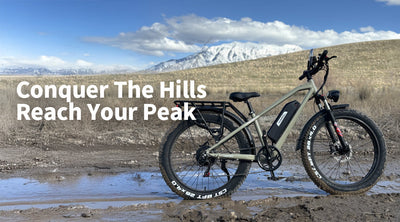
Tips & Cycling Knowledge
Conquer the Hill, Reach Your Peak——Tips for Climbing Hills on E-Bike
Riding an e-bike is amusing, but most e-bike riders are not satisfied with just riding on the flat and broadened land. They can be fond of crossing through the jungles and climbing up the hills at a thrilling speed. That's what we call "explore and challenge". While e-bikes make climbing easier, there’s still room to boost your efficiency and enjoyment. Read this passage for essential techniques for every ascent!
Gear up to Go up:
Shift Early
Don’t wait until you’re struggling on the hill to shift gears, as this can put unnecessary strain on both your legs and the e-bike’s motor. Instead, anticipate the incline ahead and shift to a lower gear before you start climbing. By doing this, you’ll maintain a smooth and steady cadence, making the climb feel more manageable and efficient. Proper gear shifting not only reduces physical effort but also ensures the motor operates optimally, extending its lifespan and conserving battery power. Planning ahead is the key to a seamless and enjoyable uphill ride!
High Torque Motor
If you’re shopping for an e-bike or considering an upgrade, prioritize one with a high-torque motor. Torque is the force that provides the power needed to tackle steep hills, making climbs feel effortless and smooth. A high-torque motor ensures consistent performance, even on challenging inclines, and reduces the strain on both the rider and the bike. Whether you’re a daily commuter or an adventure seeker, investing in a high-torque motor will transform your uphill riding experience, giving you the confidence to conquer any hill with ease.
Keep the Momentum:
Continuous Pedaling
Continuous pedaling creates a steady flow of power, making the climb smoother and preventing sudden stops or stalls that can disrupt your momentum. By maintaining a rhythmic cadence, you’ll also reduce strain on both the motor and your legs, making the uphill ride feel more manageable. This approach not only enhances efficiency but also extends your battery life, allowing you to tackle longer climbs with confidence and ease.
Minimize Braking
Avoid unnecessary braking while climbing, as it disrupts your momentum and forces you to expend extra energy to regain speed. Each time you brake, you lose the forward motion that helps carry you up the hill, making the climb feel more strenuous. Instead, focus on maintaining a steady and consistent pace throughout the ascent. By doing so, you’ll conserve energy, reduce strain on the motor, and make the climb more efficient. Planning your approach and anticipating the terrain ahead will help you keep a smooth rhythm, ensuring a more enjoyable and effortless uphill ride.
Regulate Your Position:
Lean Forward
Shift your weight slightly forward while climbing to keep the front wheel grounded and improve traction, especially on steeper slopes. This adjustment ensures better grip and stability, preventing the front wheel from lifting and helping you maintain control. Leaning forward also distributes your weight more evenly, enhancing balance and making it easier to navigate challenging inclines. By adopting this position, you’ll reduce the risk of slipping or losing momentum, allowing you to climb more efficiently and confidently. Proper weight distribution is a simple yet effective way to conquer hills with greater ease and safety.
Stay Relaxed
Keep your grip on the handlebars firm but not tense, and consciously relax your shoulders to avoid unnecessary strain. Tension in your upper body wastes energy and can lead to fatigue, making the climb feel more difficult than it needs to be. By staying loose and maintaining a relaxed posture, you’ll conserve strength and endurance, allowing you to tackle the hill more efficiently. A calm and controlled approach not only improves your riding experience but also helps you maintain better balance and control throughout the ascent.
Smart Throttle Use:
Assist But Don't Rely
Use the throttle to give yourself a boost when needed, such as when starting on a steep incline or when you need a quick burst of power. However, avoid relying on it entirely, as this can drain your battery quickly and reduce your overall riding range. Instead, combine throttle assistance with consistent pedaling to maximize efficiency. This balanced approach not only helps conserve battery life but also ensures a smoother and more controlled ride. By working in harmony with your e-bike’s motor, you’ll enjoy longer rides and a more enjoyable climbing experience.
Adjust Power
This setting provides the extra boost you need to tackle steep inclines with ease, reducing the physical effort required from your legs. By increasing the motor’s support, you can maintain a comfortable pace and conserve your energy for longer rides. However, remember to switch back to a lower assistance level on flat terrain to maximize battery efficiency. Using power modes strategically ensures a smoother, more enjoyable ride, whether you’re conquering hills or cruising on flat roads.
Final Thoughts
Climbing hills on an e-bike doesn’t have to be a struggle. By shifting early, maintaining momentum, perfecting your position, and using the throttle smartly, you can make uphill rides feel almost effortless. Remember, it’s all about working with your e-bike’s technology to get the most out of your ride. Do you have any good suggestions for riding bike on hills? Come and share your opinions with us!
Read more
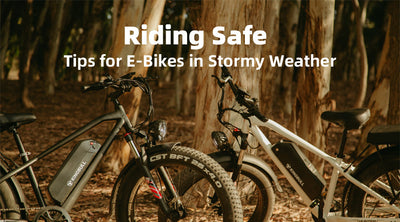
Maintenance
Riding Through the Storm: Ensuring Your E - Bike's Resilience in Inclement Weather
Hey there, fellow e-bike enthusiasts! There's no denying the sheer exhilaration and freedom that our electric bikes bring to our daily lives. However, we all know that Mother Nature can be quite the unpredictable force. Whether it's an unforeseen torrential downpour, a snow-covered landscape, or those bone-chilling winter days, adverse weather conditions can pose significant challenges to our beloved rides. But fear not! With a few well-thought-out strategies and a bit of proactive care, you can safeguard your e-bike and ensure it remains in prime condition, regardless of what the elements throw at you.
1. Shielding the Sensitive Electronics
E-bikes house a variety of delicate electronic components, with the battery and display being particularly vulnerable. These components are the lifeblood of your e-bike, and protecting them is of utmost importance. Investing in high-quality waterproof covers is a fantastic first step. These covers are specifically designed to provide a snug and secure fit, effectively repelling rain and snow. In a pinch, heavy-duty plastic bags can also serve as a makeshift solution. Just make sure to wrap them tightly around the battery and display, sealing off any potential entry points for moisture.
When it comes to storage, always prioritize keeping your e-bike indoors. If that's not possible, look for a well-sheltered area that offers protection from the elements. A covered porch, a garage, or a shed can all be great alternatives. By doing so, you're not only shielding your e-bike from direct exposure to rain and snow but also reducing the risk of damage from wind-blown debris.
2. Maintaining Chain Integrity
The chain of your e-bike is a crucial component that often bears the brunt of bad weather. Rain, snow, and slush can quickly wash away the essential lubricant that keeps the chain running smoothly. Without proper lubrication, the chain becomes prone to rust and accelerated wear, which can ultimately lead to costly repairs or even replacement.
To combat this, it's essential to use a high-quality, water-resistant bike lube on a regular basis. Make it a habit to apply the lube before and after rides, especially if you've been out in wet conditions. After riding in the rain or snow, take a few minutes to thoroughly wipe down the chain with a clean cloth. This helps to remove any dirt, grime, or moisture that may have accumulated. Once the chain is dry, reapply the lube, ensuring that every link is evenly coated. This simple routine will go a long way in extending the lifespan of your chain and maintaining optimal performance.
3. Prioritizing Tire Traction for Safety
In wet, icy, or slippery conditions, the traction of your tires can mean the difference between a safe ride and a dangerous accident. As such, it's vital to pay close attention to the condition of your tires. Start by regularly checking the tread depth. Tires with sufficient tread provide better grip on the road surface, allowing you to maintain control of your e - bike. If you notice that the tread is worn down, it's time to consider replacing the tires.
For an added boost in traction, you can experiment with adjusting the tire pressure. And here's a detailed guide on tire pressure for Kingbull electric bike tires:
Soft Terrain (such as sand or snow): Keep the pressure between 18 and 20 PSI. This lower pressure allows the tires to have a larger contact area with the soft surface, ensuring better traction and comfort. You'll feel more stable when riding on sand dunes or through a snowy path.
Daily City Riding or Paved Roads: Maintain the pressure between 20 and 25 PSI. At this level, the rolling resistance is reduced, which in turn improves the efficiency of your ride. You'll find that your e-bike glides more smoothly on the flat, hard surfaces of city streets.
Heavy Loads or Long-Distance Riding: Keep the pressure between 25 and 30 PSI. Higher pressure in these situations ensures tire stability and durability. Whether you're carrying a heavy cargo or embarking on a long journey, the tires can better withstand the continuous stress.
Special Consideration for Rainy Conditions
When it's raining, proper tire pressure adjustment becomes even more critical.
Lower the tire pressure to increase traction: On slippery wet roads, reducing the tire pressure can increase the contact area between the tires and the ground, enhancing traction and reducing the risk of skidding. However, it's important not to overdo it, as excessive reduction will increase rolling resistance, hampering riding efficiency and potentially damaging the tires.
Refer to the suggestions on the tire sidewall: Each tire's sidewall indicates the recommended tire pressure range, which serves as the fundamental reference.
Adjust according to the actual situation: The intensity of the rain, road slipperiness, and personal riding habits all factor into the optimal tire pressure choice.
Slight pressure reduction: In light rain or when the road surface is slightly slippery, decrease the tire pressure by about 5 - 10%.
Greater pressure reduction: In heavy rain or on extremely slippery roads, you can increase the reduction, but ensure the tires don't deform excessively.
Maintain balance: Keep the front and rear tire pressures balanced to prevent uneven traction.
Precautions:
Avoid excessive pressure reduction: This can lead to increased rolling resistance, reducing your e-bike's battery range and raising the risk of a tire blowout.
Check the tire pressure regularly: After riding in the rain, promptly check the tire pressure to ensure it's within the normal range.
Pay attention to the tire tread pattern: Alongside tire pressure, the tread pattern impacts traction. Opt for tires with good water-drainage capabilities to enhance safety during rainy rides.
4. Secure Storage and Theft Prevention
When your e-bike isn't in use, proper storage is key. Storing it indoors in a dry, climate- controlled area is the best way to protect it from the elements and potential damage. But even when stored indoors, it's important not to let your guard down when it comes to security. Always lock your e-bike, whether it's in your garage, basement, or apartment. A high-quality bike lock can deter would-be thieves and give you peace of mind.
Click here for more tips on how to prevent e-bike theft.
If you have no choice but to store your e-bike outdoors, invest in a durable, weather- resistant bike cover. These covers are designed to withstand harsh weather conditions, protecting your e-bike from rain, snow, sun, and wind. Make sure to choose a cover that fits your e-bike snugly and has additional features like UV protection and reinforced seams for added durability.
5. Cold-Weather Battery Care
Cold weather can have a significant impact on the performance of your e-bike's battery. As the temperature drops, the chemical reactions within the battery slow down, resulting in reduced power output and shorter battery life. To mitigate this, it's crucial to take extra care of your battery during the colder months.
For more tips on protecting your battery in cold weather, click here.
Whenever possible, store your battery indoors in a warm environment. If you're planning to go for a ride in cold weather, bring the battery inside a few hours before you leave. This allows the battery to warm up to a more optimal temperature, which can significantly improve its performance.
6. Regular Cleaning and Thorough Inspections
After braving the elements on your e-bike, it's essential to give it a thorough cleaning. Bad weather often brings with it a host of dirt, salt, and debris that can accumulate on your bike and cause damage over time. Salt, in particular, is highly corrosive and can quickly eat away at metal parts.
When it comes to cleaning, we strongly caution against using a pressure washer on e-bikes. The powerful water jet from a pressure washer not only poses a risk of damaging the electrical connections but can also force water into sensitive areas, such as the motor housing, battery compartment, or other vulnerable parts, potentially causing malfunctions.
Instead, opt for a gentle bike cleaner and a soft brush. Use them to meticulously remove all the grime from your e-bike, with special attention given to hard to-reach areas like the chain, gears, and brakes.
Once your e-bike is clean, conduct a detailed inspection. Check the brakes to ensure they're functioning properly. Test the cables for any signs of fraying or corrosion. Examine the tires for any cuts, punctures, or uneven wear. By catching these issues early on, you can prevent them from turning into more serious problems down the line. Make regular maintenance checks a part of your routine, and your e-bike will continue to serve you well for years to come.
Pro Tips
Consider using a waterproof spray on connectors and exposed metal parts. This provides an extra layer of protection against moisture and corrosion, helping to keep your e-bike's electrical system and metal components in top shape.
When storing your e-bike for an extended period, such as during the off-season, it's a good idea to remove the battery and store it separately in a temperature-controlled area. This helps to prevent the battery from discharging and extends its overall lifespan.
Stay Safe Out There!
Riding in bad weather requires extra caution. Slow down and give yourself plenty of time to react to any unexpected situations. Wear appropriate gear to keep yourself safe and comfortable. A well-fitting helmet is a must, along with a waterproof rain jacket and gloves to keep you dry and warm.
Before you head out, take a few minutes to check the weather forecast. If the conditions are too extreme, it may be best to postpone your ride. Remember, your safety should always be your top priority.
By following these comprehensive tips, you can not only protect your e-bike from the ravages of bad weather but also continue to enjoy the thrill of riding, no matter what Mother Nature has in store. So gear up, take care of your e-bike, and hit the road with confidence, rain or shine!
Read more
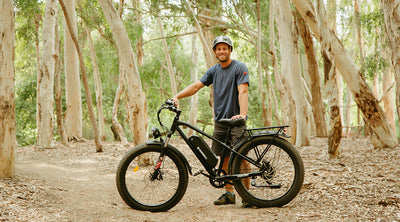
Tips & Cycling Knowledge
How Often Should You Replace Your Electric Bike Tires? A Key to Safe Riding
Electric bikes (e-bikes) have become an increasingly popular and efficient means of transportation due to their convenience and eco-friendly nature. However, many riders tend to overlook the maintenance and replacement of e-bike tires, even though they are a critical component for safety and performance. So, how often should you replace your e-bike tires? In this post, we’ll explore tire replacement guidelines, the factors affecting tire lifespan, and essential maintenance tips to ensure your safety while riding.
Factors That Affect E-Bike Tire Lifespan
The lifespan of your e-bike tires depends on several factors, including the following:
Riding Frequency and Terrain: Frequent riding or riding on rough terrains accelerates tire wear. Tires wear out much faster when used on sandy, muddy, or mountain roads.
Tire Quality: Tires from different brands and models vary in quality, durability, and lifespan. Choosing high-quality tires might involve a higher upfront cost but will reduce the need for frequent replacements.
Tire Pressure: Maintaining the right tire pressure is crucial. Both underinflation and overinflation can cause tires to wear out more quickly and increase the risk of blowouts.
Riding Habits: Hard braking, sharp turns, and other aggressive riding habits can also accelerate tire wear.
Environmental Factors: Prolonged exposure to sunlight and rain can affect the rubber, causing it to degrade and crack over time.
How to Know When Your E-Bike Tires Need Replacing
In addition to tracking the age and mileage of your tires, you can assess whether your tires need replacing by checking the following:
Tread Wear: Inspect the tread pattern. If the tread has worn down to the wear markers (usually 1.6mm or less), it’s time to replace the tire.
Aging: Check for visible cracks, bulges, or hardening on the sidewalls of the tire. These are signs of aging, and a tire in this condition should be replaced to avoid safety risks.
Damage: If your tire is punctured, cut, or frequently losing air, or if you notice it pulling to one side, it’s time for a replacement.
Recommended Tire Replacement Cycle for E-Bikes
Depending on how and where you ride, the recommended replacement cycle for your e-bike tires can vary. Here’s a general guideline:
Regular Use: If you mostly ride on city streets with good riding habits, it’s recommended to check your tires every 2-3 years for wear and aging. If the tread is noticeably worn or the tire is showing signs of aging, replace it.
Frequent Use or Harsh Terrain: If you ride frequently or on rough terrain, such as mountain trails or sandy paths, consider replacing your tires every year or two. Harsh conditions accelerate wear and tear.
Routine Inspections: Every six months, check your tire pressure, tread wear, and sidewall condition. Clean any debris, such as stones or nails, from the tread to prevent punctures.
Daily Tire Maintenance Tips
To extend the lifespan of your e-bike tires, proper care and maintenance are essential. Here are some maintenance tips:
Maintain Proper Tire Pressure: Check your tire pressure regularly and make sure it falls within the manufacturer’s recommended range. Both overinflation and underinflation can accelerate tire wear.
Avoid Aggressive Riding: Minimize hard braking and sharp turns to reduce the stress on your tires and prolong their lifespan.
Avoid Harsh Terrains: While some high-quality tires can handle rough terrain, prolonged use on dirt, sand, or muddy surfaces will wear them down faster. Avoid riding on these surfaces when possible.
Regular Cleaning: Periodically clean your tires, removing debris like stones, glass, or nails that can damage the tire and cause punctures.
CST 4.0 Fat Tires: Features and Replacement Mileage Guidelines
For riders who prefer to take on more challenging terrains, CST 4.0 Fat Tires offer a great option. Kingbull electric bikes are powered by the well-known brand CST 4.0 fat tires, CST fat tires have become the choice of American consumers because of their reliable performance. With their wider tread, these tires provide excellent grip and stability on soft or uneven surfaces like sand, snow, and mud. The lifespan of these tires can vary depending on riding conditions, riding habits, and the environment. Here’s an approximate replacement mileage for CST 4.0 Fat Tires:
Ideal Conditions (flat asphalt, good riding habits): 2,500-3,750 miles (4,000-6,000 km)
General Conditions (city roads, occasional rough terrain): 1,800-3,100 miles (3,000-5,000 km)
Harsh Conditions (mountain, sand, frequent off-road use): 1,200-2,500 miles (2,000-4,000 km)
Keep in mind that these are just rough estimates. The actual replacement timeline should depend on factors such as tread wear, aging, and how you ride. Regular inspections are key to maintaining safety.
Conclusion
Your e-bike tires are a crucial element in ensuring safe and comfortable riding. Regular checks and timely replacements are necessary to keep your bike performing at its best and to reduce the risk of accidents. By following the guidelines above, you’ll be able to keep track of when your tires need replacing and maintain their longevity.
IRemember to adjust and replace your e-bike tires according to the actual situation, and always keep an eye on the wear and aging of your tires. Safe riding starts with quality tires!
Read more

Maintenance
How to Install a Front Basket on Your Bike – A Step-by-Step Guide
Adding a front basket to your bike is a great way to increase its practicality, whether you’re commuting, running errands, or just enjoying a leisurely ride. A well-installed basket provides convenient storage without compromising the bike’s stability. In this guide, we’ll walk you through the step-by-step process of installing a front basket, including repositioning the front light for a seamless fit.
Step 1: Remove the Front Light
Remove the original front light to make room for the front basket installation.
Step 2: Attach the Front Basket
Align the holes of the front basket with the reserved mounting holes on the bike frame, then secure it using washers and screws.
Step 3: Install the Bracket
Install the new bracket in the designated slot at the front of the basket. Pay attention to the bracket's installation direction.
Step 4: Reinstall the Front Light
Remove the original front light bracket and install the front light onto the new bracket. After installation, reconnect the wiring to complete the setup.
Final Thoughts
With your front basket properly installed, your bike is now more functional and stylish! Whether you're carrying groceries, a backpack, or other essentials, this upgrade will make your rides more convenient. Happy cycling!
Read more
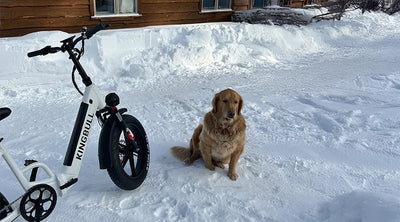
Tips & Cycling Knowledge
Who Let the Dogs Out-How to Ride with Your Furry Friends?
While we are rushing out for fresh air on our e-bike, our furry puppies are also eager to go out with us, running freely on the grassland and exploring the melting town, especially in this warm and blooming season. It is a good idea to ride along with your lovely pet dogs, but how can we and our furry friends enjoy the leisure outdoor time together? Here are some tips for you.
Train Your Dog First & Start Slow
Dogs aren’t born knowing how to jog beside an e-bike—patience is key! Begin with short, slow rides to let your dog adjust to the rhythm of running alongside you.
Warm up walk first
Before hopping on your e-bike, begin with a short warm-up walk. Attach your dog’s leash and walk beside you, keeping it rolled slowly by your side. This helps your dog associate the bike with calm, positive experiences while learning to stay focused on your movements. Use a relaxed leash to avoid tension, and let them sniff or explore briefly to ease nerves. Reward steady pacing with treats or praise, reinforcing that the bike isn’t a threat. This simple ritual builds trust and familiarity, ensuring smoother rides ahead!
Gradual Acceleration
Begin pedaling at a slow, walking pace to match your dog’s natural rhythm. As they grow comfortable running alongside the bike, gradually increase your speed in small increments. Watch for signs of confidence, like steady pacing and relaxed body language, and avoid sudden bursts of speed. This step-by-step approach helps your dog build stamina and trust, ensuring a safe and enjoyable biking experience for both of you.
Pick The Right Gear
Safety gear isn’t just for humans! The right equipment keeps your dog secure and comfortable during rides.
Bike Attachments
Choosing the right bike attachment is essential for a safe and enjoyable ride. For medium to large dogs, opt for a hands-free leash, such as a spring-loaded “bike tow leash,” which absorbs shock and keeps your dog at a safe distance from the wheels. For smaller dogs, consider a secure front/back basket or trailer designed for pets, ensuring they’re comfortably seated and protected. Always test the attachment at home first to ensure your dog feels safe and the equipment is stable before hitting the road
Hydration on the Go
Hydration is crucial during biking adventures. Carry a lightweight, collapsible water bowl and a bottle of fresh water for your dog. Offer frequent breaks, particularly on warm days, to prevent overheating. Watch for signs of dehydration, like excessive panting, and let your dog drink small amounts regularly. Staying hydrated keeps your pup energized and ready for the next leg of the journey!
Know Your Dog’s Limit
Not every dog is built for marathon e-biking sessions. Respect their physical and mental limits to keep adventures enjoyable.
Watch for fatigue
Always monitor your dog for signs of fatigue during your ride. Heavy panting, slowing down, lagging behind, or suddenly lying down are clear indicators that it’s time to stop and rest. Overexertion can lead to heatstroke or injury, so take breaks in shaded areas and offer water. Pay attention to your dog’s energy levels and adjust the ride length or intensity to ensure they stay happy, healthy, and ready for more adventures.
Awareness of Weather
Weather awareness is critical when biking with your dog. Avoid riding in extreme heat or cold, as dogs are more vulnerable to temperature changes. In summer, opt for early mornings or evenings when it’s cooler, and stick to shaded trails to prevent overheating. In winter, protect their paws from icy surfaces. Always check the forecast and prioritize your dog’s comfort and safety to ensure a fun, stress-free adventure.
Conclusion
Cycling with your dog on e-bike isn’t just about exercise—it’s about teamwork, trust, and shared joy. By starting slow, using the right gear, and respecting your pup’s needs, you’ll turn every ride into a wagging-tail adventure. Kingbull bike is such a great fellow with you and your pet dogs, so grab that leash, pump those tires, and let the good times roll! Take some photos to reminisce these unforgettable moments and share your stories with us!
Read more




